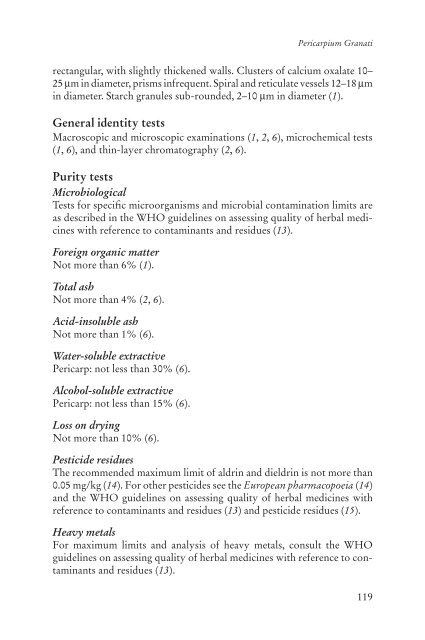WHO monographs on selected medicinal plants - travolekar.ru
WHO monographs on selected medicinal plants - travolekar.ru WHO monographs on selected medicinal plants - travolekar.ru
Pericarpium Granati rectangular, with slightly thickened walls. Clusters of calcium oxalate 10– 25 m in diameter, prisms infrequent. Spiral and reticulate vessels 12–18 m in diameter. Starch granules sub-rounded, 2–10 m in diameter (1). General identity tests Macroscopic and microscopic examinations (1, 2, 6), microchemical tests (1, 6), and thin-layer chromatography (2, 6). Purity tests Microbiological Tests for specific microorganisms and microbial contamination limits are as described in the
- Page 76 and 77: WHO monogr
- Page 78 and 79: WHO monogr
- Page 80 and 81: WHO monogr
- Page 82 and 83: WHO monogr
- Page 84 and 85: WHO monogr
- Page 86 and 87: WHO monogr
- Page 88 and 89: WHO monogr
- Page 90 and 91: WHO monogr
- Page 92 and 93: WHO monogr
- Page 94 and 95: WHO monogr
- Page 96 and 97: WHO monogr
- Page 98 and 99: WHO monogr
- Page 100 and 101: Folium Cynarae Definition Folium Cy
- Page 102 and 103: WHO monogr
- Page 104 and 105: WHO monogr
- Page 106 and 107: WHO monogr
- Page 108 and 109: WHO monogr
- Page 110 and 111: WHO monogr
- Page 112 and 113: WHO monogr
- Page 114 and 115: WHO monogr
- Page 116 and 117: Cortex Granati Definition Cortex Gr
- Page 118 and 119: WHO monogr
- Page 120 and 121: WHO monogr
- Page 122 and 123: WHO monogr
- Page 124 and 125: WHO monogr
- Page 128 and 129: WHO monogr
- Page 130 and 131: WHO monogr
- Page 132 and 133: WHO monogr
- Page 134 and 135: WHO monogr
- Page 136 and 137: WHO monogr
- Page 138 and 139: WHO monogr
- Page 140 and 141: WHO monogr
- Page 142 and 143: WHO monogr
- Page 144 and 145: WHO monogr
- Page 146 and 147: WHO monogr
- Page 148 and 149: Lichen Islandicus Definition Lichen
- Page 150 and 151: WHO monogr
- Page 152 and 153: WHO monogr
- Page 154 and 155: WHO monogr
- Page 156 and 157: WHO monogr
- Page 158 and 159: WHO monogr
- Page 160 and 161: WHO monogr
- Page 162 and 163: WHO monogr
- Page 164 and 165: WHO monogr
- Page 166 and 167: WHO monogr
- Page 168 and 169: WHO monogr
- Page 170 and 171: WHO monogr
- Page 172 and 173: WHO monogr
- Page 174 and 175: WHO monogr
Pericarpium Granati<br />
rectangular, with slightly thickened walls. Clusters of calcium oxalate 10–<br />
25 m in diameter, prisms infrequent. Spiral and reticulate vessels 12–18 m<br />
in diameter. Starch granules sub-rounded, 2–10 m in diameter (1).<br />
General identity tests<br />
Macroscopic and microscopic examinati<strong>on</strong>s (1, 2, 6), microchemical tests<br />
(1, 6), and thin-layer chromatography (2, 6).<br />
Purity tests<br />
Microbiological<br />
Tests for specific microorganisms and microbial c<strong>on</strong>taminati<strong>on</strong> limits are<br />
as described in the <str<strong>on</strong>g>WHO</str<strong>on</strong>g> guidelines <strong>on</strong> assessing quality of herbal medicines<br />
with reference to c<strong>on</strong>taminants and residues (13).<br />
Foreign organic matter<br />
Not more than 6% (1).<br />
Total ash<br />
Not more than 4% (2, 6).<br />
Acid-insoluble ash<br />
Not more than 1% (6).<br />
Water-soluble extractive<br />
Pericarp: not less than 30% (6).<br />
Alcohol-soluble extractive<br />
Pericarp: not less than 15% (6).<br />
Loss <strong>on</strong> drying<br />
Not more than 10% (6).<br />
Pesticide residues<br />
The recommended maximum limit of aldrin and dieldrin is not more than<br />
0.05 mg/kg (14). For other pesticides see the European pharmacopoeia (14)<br />
and the <str<strong>on</strong>g>WHO</str<strong>on</strong>g> guidelines <strong>on</strong> assessing quality of herbal medicines with<br />
reference to c<strong>on</strong>taminants and residues (13) and pesticide residues (15).<br />
Heavy metals<br />
For maximum limits and analysis of heavy metals, c<strong>on</strong>sult the <str<strong>on</strong>g>WHO</str<strong>on</strong>g><br />
guidelines <strong>on</strong> assessing quality of herbal medicines with reference to c<strong>on</strong>taminants<br />
and residues (13).<br />
119



